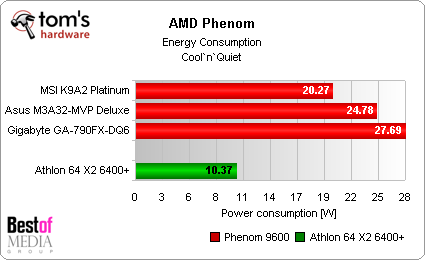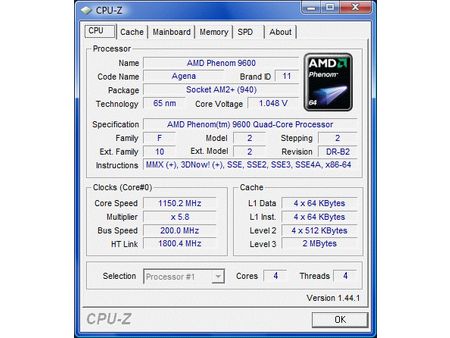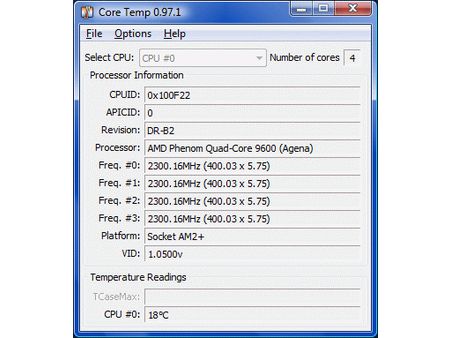35 AMD CPUs Tested for Power Consumption
AMD Phenom: Up to 27 Watts During Standby
Before we get to the comparison tests of all the AMD processors, we would like to talk about a problem with the Phenom processor. During our testing, we found out that, in comparison to all other AMD CPUs, the Phenom has a very high power draw during standby. Even when Cool’n’Quiet mode is activated, depending on which motherboard is used, the energy intake is almost three times higher.
The Phenom 9600 processor switches down to a clock rate of 1150 MHz during standby mode. Its multiplier then becomes 5.8x and the core voltage goes down to 1.050 V.
In order to find out where the processor’s high power intake comes from, we measured our Phenom 9600 Black Edition on AMD 790FX boards from Asus, Gigabyte and MSI.

In our opinion, the electrical intakes of all three motherboards are too high to be acceptable. We measured 27.69 W on the Gigabyte board, while the MSI board achieved 20.27 W, which at its best is twice as much as the Athlon 64 X2 6400+.
Surprisingly, there is a difference of up to 7.4 W between the MSI and Gigabyte motherboards. While the MSI motherboard has a 5-phase regulator and the Gigabyte board is equipped with a 10-phase regulator, it’s unlikely that the Gigabyte’s additional 5-phase regulator uses more than 7.4 watts. There is the possibility that the Phenom doesn’t switch down to a lower voltage properly, which cannot be detected with classic diagnostic tools like CPU-Z, Core-Temp or Everest.
The Phenom 9600 needs up to 20.27 watts during standby, even with Cool’n’Quiet mode turned on. With the Gigabyte board it even goes up to 27.69 W. When compared to the Athlon 64 X2 6400+, the electrical intake is simply too high.
Get Tom's Hardware's best news and in-depth reviews, straight to your inbox.
Current page: AMD Phenom: Up to 27 Watts During Standby
Prev Page Measuring Devices and Testing Methods Next Page Testing 35 AMD Processors-
Excellent article! It would be nice to see similar article for Intel processors because even if they are less power hungry, the Intel chipsets are not the "greenest". I am just considering a 24/7 home server and this information is very useful for me. Thank you!Reply
-
Good article! You have the wrong processor name listed for the 2.10 GHz G1 Brisbane as "Athlon 64 X2 4800+ EE". It should be 4000+. I was a bit confused when I read the performance charts and noticed two 4800+ listed until I realized the mistake.Reply
-
xoham Intel is not the greenest if it is less power hungry? Do they not meet RoHS standard or something?Reply -
zenmaster He said the "Intel Chipsets" are not the greenest.Reply
The are still built on the 90nm process.
The P45 will introduce the 65nm process on the chipsets.
The latest AMD Chipsets use the 55nm process.
In regards to CPUs, The Intel CPUs generally use less than the AMD CPUs.
He was simply pointing out that the CPUs lose some of the benefeit of their low power consumption due to the chipset.
For lower-end chips sitting idle, the difference in power usage of the chipsets can be significant. If you are looking at a higher-end chip under load, the power usage of the chipset becomes nominal. -
einheriar besides that intel still has the memory controller as a separate chip on the motherboard, where as amd has that included on the chip.. therefor a higher chip power use might be offset by the absence of the external memory controller, which would become visible when idling ..Reply -
so my x2 4000 ee (in tables interpreted as one of 4800's - due mistake) isn't so bad after all, I don't care about 2w/hour, when I have 24" lcd :-)Reply
-
Mathos The extra power consumption on the Phenom is due to the fact that the NB/IMC voltage stays at 1.250v even when the rest of the processor is running in standby. Kinda of annoying that they put it that high, since with a bios that still has the p-states section you can easily under volt the IMC without losing stability, especially at stock speeds. That will cut down on the idle and load power usages drastically.Reply -
royalcrown I like how review site all push efficiency now since AMD can't really compete on performance. Yawn.Reply -
jprevost Bravo for a great technical article. I can't tell you guys how nice it is to see some great charts. Charts are good, and you guys are good at charts, just don't stop adding to them!Reply

